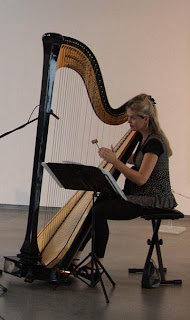Obecní
dům
June
24
 |
| A choreographed cacophony of music and movement. |
Probably
more bands than would care to admit it got their start in
alcohol-fueled jams. For Mnozil Brass, the rambunctious Austrian
septet that will take the stage at Obecní dům on
Sunday night, itʼs a point of pride.
“We
were all studying at the University of Music and Performing Arts in
Vienna in the early ʼ90s,” explains Wilfried Brandstötter,
the groupʼs tuba player. “After classes, we went very frequently
to a pub right in front of the university called Josef Mnozilʼs Inn,
where there was a big jam session once a month. Because we all came
from brass and wind bands in Austria, we found that we had a
common repertoire: 10 marches, 10 waltzes and 10 polkas. So we didnʼt
even have to rehearse. We just started playing together.”
The
band has evolved into a tight unit that typically tours 20 countries
a year, serving up a mix of boisterous playing, physical comedy and
mischievous arrangements of a repertoire that ranges from Rossini to
Henry Mancini to Queen. Their approach to music is perhaps best
summarized by Brandstötterʼs
description of his instrument: “The other players say my tuba is an
unguided missile. Itʼs a weapon of mass destruction.”
Though
there is no direct model for Mnozil Brass, the group takes
inspiration from one of the wackiest American bands of the 1940s and
ʼ50s. “We
really love Spike Jones and the City Slickers,” Brandstötter
says. “Itʼs surprising how good those guys were – on point every
second. Their videos are 50, 60 years old, but still very fast and
very funny.”
Like
Spike Jones, Mnozil Brass puts on a show that appears to be pure
anarchy, but is in fact exhaustively rehearsed and choreographed. It
starts with the band members bringing ideas and music to planning
sessions, with no restrictions whatsoever.
“We
are very democratic when we come together,” Brandstötter
says. “Maybe someone has been listening to Prokofiev a lot, and he
says, Iʼd like to play this piece. So we try it out, and if it
works, itʼs in the show.”
But
thatʼs only half the performance. The other half is comedy routines
that can take up to six months to put together. “For instance, in
the program we are doing now, we have an Olympic competition that
involves running and boxing and weight-lifting” Brandstötter
says. “This really took quite a lot of time to develop, because
everybody has to know what heʼs doing every second, or the jokes
donʼt work.”
That
show, which the band will be performing in Prague, is titled
“Blofeld” – as in Ernst Stavro Blofeld, James Bondʼs
archenemy. Asked what the audience can expect, Brandstötter
will only say, “The show is about good and evil – with a lot of
references to James Bond scenes, of course.”
Despite
the emphasis on theatrics, Mnozil Brass performances are nonverbal,
so they can travel worldwide with no problem. And Brandstötter
and his colleagues have found that their musical vocabulary needs no
translation.
“Sometimes
we put musical jokes in the pieces, like inserting one bar from
another piece, and you can hear people laughing,” he says. “In
Japan, weʼve found that people are much more educated about Western
music, like Mozart and Strauss and Stravinsky, than people in Austria
or America. The Japanese are so into that music, they know every
piece you play – which is amazing.”
When
Mnozil Brass played at the opening concert of the Wiener Festwochen
last month, an audience of nearly 40,000 people reacted so
enthusiastically that two members of the band never made it back
onstage for the encore, with one conveniently getting trapped at a
beer stand. Czech audiences can identify with the beer part; as for
the rest, Brandstötter
simply envisions an enjoyable evening.
“The
main goal of our show is to put on good entertainment that makes
people feel relaxed and comfortable,” he says. “If they leave
saying, Iʼve not thought about my sorrows for the past two and a
half hours, then it was a big success.”
For
more on Mnozil Brass:
http://www.mnozilbrass.at/index.php?id=24&L=1
For
a sampling of Spike Jones:
http://www.youtube.com/watch?v=A0dw2UKRYSA
Photo by Carsten Bunnemann












